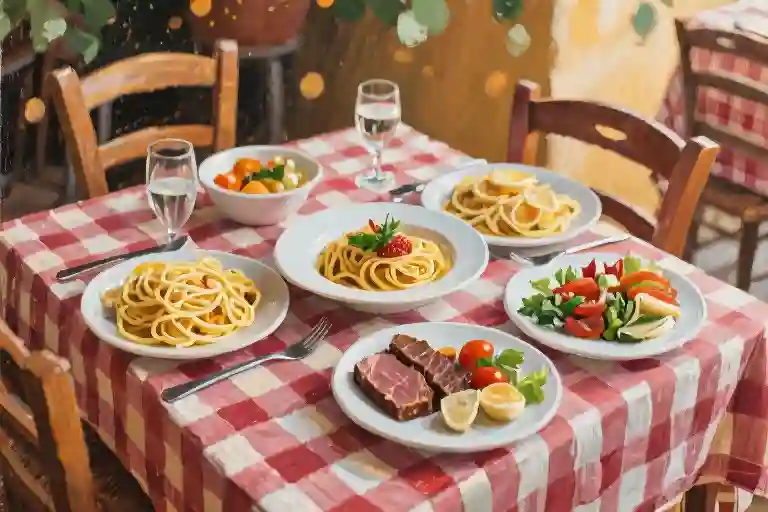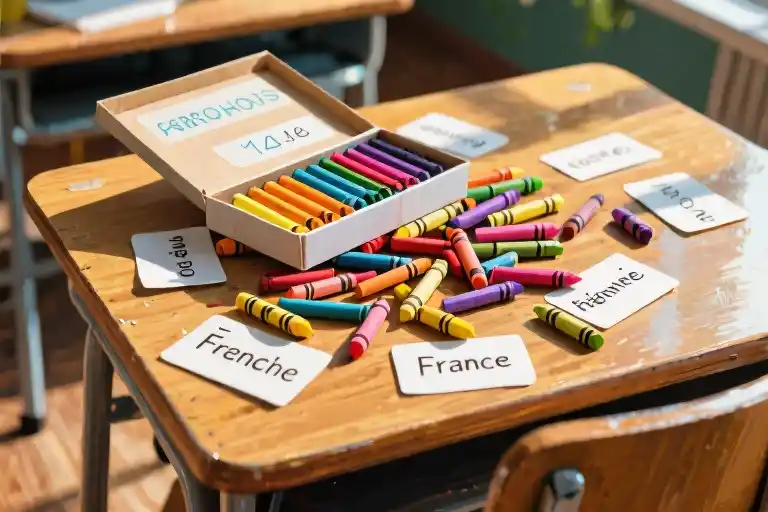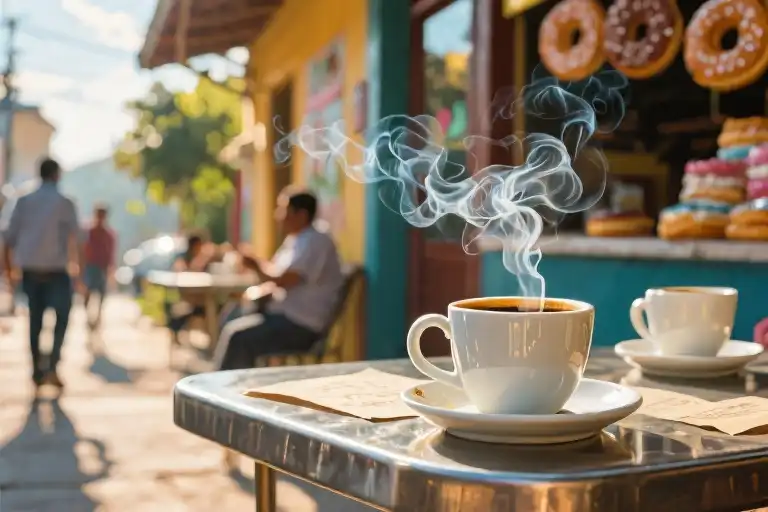You’re sitting in a charming trattoria in Rome, the aroma of garlic and fresh basil wafting through the air. The waiter hands you a menu, and suddenly those carefully memorized Italian food words scramble in your brain. Is “spaghetti carbonara” an antipasto or a primo? Why does the menu list both “primi” and “secondi” under main courses? And what exactly should you order if you’re vegetarian?
As an Italian language teacher, I’ve seen this confusion play out countless times in my classroom. During our food unit, I’ll ask students to categorize dishes like “bruschetta,” “risotto ai funghi,” and “saltimbocca alla romana.” While most can identify desserts (everyone remembers tiramisu!), about 70% initially place hearty pasta dishes under “secondi” – until they learn Italy’s unique culinary logic.
This guide will decode the Italian menu structure that puzzles so many visitors and language learners. We’ll explore:
- The five essential menu categories and their cultural significance
- Why Italy’s two-main-course tradition developed (and how to navigate it without overordering)
- Key vocabulary to confidently order anything from fresh pasta to vegan secondi
- Real-life phrases to use when the waiter asks “Primo o secondo?”
By the end, you’ll understand why that bowl of pappardelle al ragù isn’t the “main event” – and how to craft a perfectly balanced Italian meal just like locals do. Let’s begin with the golden rule: Italian menus aren’t organized by meal progression, but by food groups that create a specific dining rhythm.
The Golden Structure of an Italian Menu
Navigating an Italian menu can feel like deciphering a culinary map at first glance. Unlike the single “main course” structure common in many countries, Italian dining follows a carefully orchestrated sequence designed to satisfy both appetite and tradition. Let’s break down this five-act gastronomic performance that takes diners from appetizers to sweet finales.
The Five Pillars of Italian Dining
- Antipasti (Appetizers)
These light starters awaken the palate rather than fill the stomach. Think bruschetta with ripe tomatoes, delicate slices of prosciutto, or marinated olives. Many visitors mistakenly equate antipasti with salads, but authentic Italian menus often list insalata separately. - Primi (First Courses)
Here’s where the magic begins – an entire course dedicated to carbohydrates. This isn’t just pasta; it includes risottos, soups (like ribollita), and gnocchi. A common misconception is treating primi as a side dish when it’s actually a substantial course on its own. - Secondi (Second Courses)
The protein showcase featuring meats (bistecca alla Fiorentina), fish (branzino al forno), or vegetarian alternatives like melanzane alla parmigiana. Unlike American main courses, these are usually served without starches – that’s what your primo was for! - Contorni (Side Dishes)
Vegetables or potatoes ordered separately to accompany secondi. Roasted artichokes (carciofi alla romana) or sautéed greens (spinaci saltati) are classics. Forgetting to order these might leave you with just a lonely piece of meat on your plate. - Dolci (Desserts)
From tiramisu to panna cotta, these sweet endings maintain regional pride. Northern Italy favors creamy desserts, while the south excels at citrus-infused pastries.
Menu Navigation Cheat Sheet
| Italian Term | English Equivalent | Typical Dishes | Key Notes |
|---|---|---|---|
| Antipasti | Appetizers | Bruschetta, Caprese salad | Light portions, often shared |
| Primi | First courses | Spaghetti carbonara, Risotto alla milanese | Carb-heavy, substantial portions |
| Secondi | Second courses | Grilled sea bass, Veal scallopini | Protein-focused, often needs contorno |
| Contorno | Side dishes | Roasted potatoes, Sautéed spinach | Ordered à la carte with secondi |
| Dolci | Desserts | Tiramisu, Cannoli | Regional variations abound |
Why Two Main Courses? A Cultural Insight
This dual-course system stems from Italy’s agricultural history. Primi provided affordable energy through grains to laborers, while secondi (traditionally more expensive) offered occasional protein. Modern Italians maintain this structure because:
- Pacing: Allows slower, more social dining
- Balance: Prevents overloading one plate
- Tradition: Maintains connection to culinary heritage
During economic hardships in the early 20th century, many families could only afford primi, making secondi a special occasion treat. Today’s portion sizes reflect this history – primi are substantial enough to be a meal alone, while secondi remain modest without contorni.
Pro Tip: Tourists often make the mistake of ordering both primi and secondi without realizing the cumulative portion size. Consider sharing courses or opting for either a primo or secondo with contorno for a balanced meal.
Understanding this structure transforms menu anxiety into confident ordering. Next time you see “osso buco” listed under secondi, you’ll know it’s not preceded by a typo – that space is reserved for the risotto that traditionally accompanies it!
Primi and Secondi: More Than Just “First” and “Second”
Many first-time visitors to Italy make the same surprised observation: Italian menus don’t follow the familiar starter-main course-dessert structure. Instead, you’ll encounter two substantial courses listed as “primi” and “secondi” – a dining tradition that often leaves newcomers both delighted and slightly overwhelmed.
The Carb-Protein Duo: Understanding the Italian Approach
Primi (first courses) form the foundation of Italian meals, typically featuring carbohydrate-rich dishes like:
- Pasta (both dried and fresh varieties)
- Risotto (creamy rice dishes)
- Soup (especially in colder months)
- Gnocchi (potato dumplings)
Secondi (second courses) complete the meal with protein-focused options:
- Meat dishes (veal, chicken, rabbit)
- Fish and seafood
- Egg-based dishes (in simpler trattorias)
- Modern vegetarian/vegan alternatives
What surprises many visitors is that these aren’t sequential courses in the French style, but complementary components of a complete meal. Italians might combine a light primo with a substantial secondo, or vice versa, creating balanced nutrition through this unique two-part structure.
Historical Roots: From Banquets to Family Tables
This culinary tradition traces back to medieval Italian banquets where nobility would enjoy multiple elaborate courses. Over centuries, the two most substantial elements – the grain-based dish and the protein course – became standardized in everyday dining. Even today, this structure reflects Italy’s agricultural history, where wheat and rice provided affordable sustenance while meat remained a valuable occasional addition.
Common Missteps (And How to Avoid Them)
During my years teaching Italian, I’ve seen students make predictable mistakes with menu navigation:
The Risotto Confusion
Many mistake risotto (always a primo) for a main course due to its richness. Ordering it as your secondo leaves you without protein – like having mashed potatoes as your entree.
The Double Pasta Dilemma
Tourists sometimes order pasta both as antipasto and primo, then struggle when the secondo arrives. Remember: antipasti are light starters like bruschetta or cured meats.
The Missing Contorno
Secondi often come without vegetables unless you specifically order a “contorno” (side dish). A simple “Con un contorno di verdure, per favore” ensures balanced nutrition.
Modern Adaptations
Contemporary dining has introduced flexibility to this tradition:
- Smaller portion combinations (“mezzo piatto” options)
- Vegetarian/vegan primi with plant-based proteins
- Business lunch menus offering primo OR secondo choices
Yet even with these adaptations, understanding the primi-secondi distinction remains key to enjoying Italian dining culture authentically. When in doubt, observe how locals order or ask your server for guidance – “Cosa mi consiglia?” (What do you recommend?) opens doors to wonderful culinary experiences.
Ordering Like a Local: Your Italian Restaurant Survival Guide
Navigating an Italian menu goes beyond just recognizing dish names—it’s about understanding the unspoken rules of ordering. Let’s break down the process into actionable steps so you can dine with confidence.
The Essential Phrasebook
These key expressions will serve as your culinary compass:
- Initiating the order:
“Per cominciare, vorrei…” (pehr koh-meen-CHAH-reh, vor-RAY) – “To start, I’d like…” - For primi:
“Come primo, prendo…” (KOH-meh PREE-mo, PREN-doh) – “As my first course, I’ll have…” - Transitioning to secondi:
“Poi, come secondo, mi consiglia…?” (poy, KOH-meh seh-KON-doh, mee kon-SEE-lyah) – “Then, for the second course, what would you recommend?” - Special requests:
“È possibile avere… senza glutine?” (eh pos-SEE-bee-leh ah-VEH-reh… SEN-zah GLOO-tee-neh) – “Is it possible to have… gluten-free?”
The Ordering Flowchart
- Aperitivo (Optional pre-meal drink):
“Un Aperol spritz, per favore” (oon ah-peh-ROL spritz, pehr fah-VOH-reh) - Antipasti:
“Condividiamo un antipasto misto” (kon-dee-vee-DYAH-mo oon an-tee-PAH-sto MEE-sto) – “Let’s share a mixed starter” - Primi:
“Per me, gli gnocchi al pomodoro” (pehr meh, lyee NYOK-kee ahl poh-moh-DOH-roh) - Pause:
Waiters will never rush you—take time between courses - Secondi + Contorno:
“Il filetto al pepe verde con patate arrosto” (eel fee-LET-to ahl PEH-peh VEHR-deh kon pah-TAH-teh ahr-ROH-sto) – “Pepper steak with roasted potatoes” - Dolci/Caffè:
“Un tiramisù e poi un caffè” (oon tee-rah-mee-SOO eh poy oon kahf-FEH)
Dietary Needs Made Simple
For vegetarian/vegan options:
- “Avete opzioni vegetariane/vegane?” (ah-VEH-teh op-TSYOH-nee veh-jeh-TAH-ryah-neh/veh-GAH-neh)
- Modification example: “Pasta alla carbonara senza pancetta” (PAH-stah AHL-lah kar-bo-NAH-rah SEN-zah pan-CHET-tah)
For allergies:
- “Sono allergico/a a…” (SOH-noh ahl-LEHR-jee-koh/kah ah) – “I’m allergic to…”
- Common allergens:
- Noci (NOH-chee) – Nuts
- Latticini (laht-tee-CHEE-nee) – Dairy
- Crostacei (kroh-STAH-cheh-ee) – Shellfish
Pro Tips to Avoid Faux Pas
- Bread protocol:
- Served without butter/oil
- Meant to “fare la scarpetta” (FAH-reh lah skar-PET-tah) – mop up sauce
- Cheese requests:
- Never ask for parmesan on seafood pasta
- “Posso avere del parmigiano?” (POS-soh ah-VEH-reh del par-mee-JAH-no)
- Pasta rules:
- Twirl spaghetti with fork only (no spoon)
- Cutting pasta is frowned upon
- Timing matters:
- Lunch: 12:30-2:30pm
- Dinner: 7:30-10:30pm
- “Siamo ancora aperti?” (SYAH-mo an-KOH-rah ah-PEHR-tee) – “Are you still open?”
Handling the Bill
- “Il conto, per favore” (eel KON-toh, pehr fah-VOH-reh)
- Service charge (coperto) is usually €1-3 per person
- Tipping: Round up or leave 5-10% for exceptional service
- Splitting: “Possiamo dividere?” (pos-SYAH-mo dee-VEE-deh-reh)
Remember, Italians appreciate when you engage with their culinary traditions. A simple “È squisito!” (eh skwee-ZEE-toh) – “It’s delicious!” will make any server smile.
Beyond Spaghetti: Navigating Italy’s Pasta Universe
While spaghetti may be Italy’s most famous pasta export, the country’s culinary tradition offers a dazzling variety that goes far beyond this ubiquitous strand. Understanding the nuances between pasta types will transform your dining experience from touristy to authentically Italian.
The Dry vs. Fresh Pasta Divide
Italian supermarkets present an overwhelming wall of pasta options, but two key categories dominate:
Pasta secca (dried pasta)
- Made from durum wheat semolina and water
- Recognizable by its golden hue and brittle texture
- Look for these quality indicators on packaging:
- Trafilata al bronzo (bronze-die extruded) for rougher sauce-adhering texture
- Grano italiano (Italian wheat) for authentic flavor profile
- Drying time (24+ hours indicates traditional methods)
Pasta fresca (fresh pasta)
- Typically contains eggs for richer flavor
- Perishable, often sold refrigerated
- Regional specialties to seek out:
- Rome’s tonnarelli (square-cut spaghetti for cacio e pepe)
- Emilia-Romagna’s silk-like tagliatelle (perfect for ragù)
- Piedmont’s agnolotti (delicate stuffed pockets)
North vs. South: A Pasta Geography Lesson
Italy’s culinary map reveals fascinating regional pasta personalities:
Northern Staples
- Risotto: Creamy rice dishes often mistaken for primi
- Pappardelle: Wide ribbons for hearty game sauces
- Pizzoccheri: Buckwheat pasta from Valtellina
Southern Stars
- Orecchiette: “Little ears” from Puglia
- Busiate: Sicilian corkscrews for pesto Trapanese
- Scialatielli: Amalfi Coast’s thick, short strands
Pro tip: Coastal regions often pair pasta with seafood, while inland areas favor meat sauces – let geography guide your ordering.
Decoding Restaurant Menus Like a Local
When scanning primi lists, these descriptors reveal preparation styles:
- Al forno: Baked (like lasagna)
- Ripieni: Stuffed (ravioli, tortellini)
- In brodo: Served in broth
- Alla chitarra: Cut on wire-stringed “guitar”
Remember: Italians consider breaking pasta (except for children) a culinary crime – twirl those strands with pride!
This pasta primer arms you with knowledge to venture beyond spaghetti confidently. Whether choosing artisanal dried varieties or seeking out regional fresh specialties, you’re now equipped to explore Italy’s magnificent pasta diversity.
Now You’re Ready to Order Like a Local!
Congratulations! You’ve just unlocked the secret code to navigating Italian menus with confidence. No more nervously pointing at random dishes or ending up with three pasta courses (unless that’s your goal – no judgment here!).
Remember when we started this journey together? That moment of staring blankly at an Italian menu, wondering why there were two “main courses”? Now you can:
- Spot the difference between primi and secondi at a glance
- Confidently ask for pasta senza carne (without meat) if needed
- Appreciate why that plate of tagliatelle al ragù belongs in the primi section
- Even impress your server by properly ordering contorno with your secondo
Continue Your Italian Food Adventure
Hungry for more? Dive deeper into Italy’s rich culinary culture with our guide to Italian Coffee Culture – because navigating espresso etiquette is just as important as ordering pasta!
Let’s Hear From You
We’d love to know:
- Which Italian dish confused you the most before reading this guide?
- Have you ever accidentally ordered only primi thinking it was the main course?
- What’s your favorite pasta shape you’ve discovered?
Drop your stories in the comments below – your experience might help fellow readers avoid delicious but potentially overwhelming Italian menu mishaps!
Arrivederci e buon appetito! (Goodbye and enjoy your meal!)





